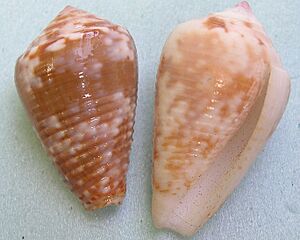Conus catus facts for kids
Quick facts for kids Conus catus |
|
|---|---|
 |
|
| Shell of Conus catus | |
| Conservation status | |
| Scientific classification | |
| Synonyms | |
|
Conus catus, also known as the cat cone, is a type of sea snail. It's a marine gastropod mollusk that belongs to the Conidae family, often called cone snails. These snails were first described in 1792.
Like all species in the Conus group, these snails are predatory, meaning they hunt other animals for food. They are also venomous, which means they can sting. Their sting can be harmful to humans. Because of this, it's very important to be careful and avoid touching live cone snails.
What Does the Cat Cone Snail Look Like?
The shell of an adult cat cone snail can be between 24 mm and 52 mm long. The shell has a rounded, spire (the pointed top part). The main part of the shell, called the body whorl, has lines or grooves. These lines are usually smooth at the top and bumpy at the bottom.
The shell comes in many colors, like olive, chestnut, chocolate, or pink-brown. It often has white patterns and spots. Sometimes, it has a faint white band around the middle. There's a special type called nigropunctatus where the shell has chocolate-colored dots in rows.
Where Do Cat Cone Snails Live?
This species of cone snail lives in warm ocean waters around the world. You can find them in the Red Sea and parts of the Indian Ocean. This includes places like the Aldabra Atoll, Chagos, Madagascar, Mauritius, Tanzania, and KwaZuluNatal in South Africa.
They also live in the tropical Indo-West Pacific Region. This area includes places like Papua New Guinea, the Marquesas Islands, and New Caledonia. In Australia, they are found off the coasts of New South Wales, the Northern Territory, Queensland, and Western Australia.


